You can do this by:
- Generating a cardinal spline based on random line points
- Walk along that line and plot a star on current position
Why cardinal spline? A cardinal spline will generate a smooth line between a set of points. If also has a tension value. By exaggerating the tension value (i.e. outside the normal [0,1] range) it will produce curly lines instead.

// draw example lines
var ctx = c.getContext("2d"), p = [0,100, 25,40, 50,70, 75,50, 100,80, 125,32, 150,100, 175,60];
ctx.font = "bold 16px sans-serif";
render(0); render(0.5); render(-2);
ctx.setTransform(1,0,0,1,0, 110);
render(-2, 3, "Segments: 3"); render(-2, 9, "Segments: 9"); render(-2, 25, "Segments: 25");
function render(t, seg, txt) {
ctx.beginPath();
ctx.moveTo(0, 100);
ctx.curve(p, t, seg || 20);
ctx.stroke();
ctx.fillText(txt ? txt : (!t ? "Plain poly-line" : "Cardinal, tension: " + t), 0, 20);
ctx.translate(200,0);
}
We can take advantage of this property and plot a point along such a line to produce a liquid-ish movement. The movement can be refined by de/increase the segment resolution between each line in the spline which will affect the smoothness as well as the speed.
Other advantages is that we don't have to calculate anything in the animation itself (there will be an initial "peak" when setting up the points (cache) though), we just update the array pointer and render. And the distribution will be fairly even as the points are forces along somewhat evenly distributed (invisible) paths.
How to implement it can vary of course - here is one example of an approach:
Example implementation
Define a star object (it should really be prototyped but for the sake of demo):
function Star(ctx, xseg) {
var points = [], // holds points for cardinal points
cPos = 0, oPos = -1, // positions in line
len,
w = ctx.canvas.width,
x = -10, y = -10;
// this iterates and loop the point list
this.animate = function() {
cPos++;
if (cPos > len - 2) {
cPos = 0; oPos = -1;
}
var pos = cPos * 2;
x = points[pos];
y = points[pos + 1];
drawStar();
}
// render some star
function drawStar() {
ctx.rect(x, y, 2, 2);
}
// This generate a set of random points, then converts those into
// points for a cardinal spline (linked as script).
function generatePath() {
var w = ctx.canvas.width,
h = ctx.canvas.height,
numOfSeg = 20,
dh = h / numOfSeg,
i= 0, l, x, y;
for(; i<= numOfSeg; i++) {
x = xseg + w / 8 * Math.random();
y = h - (i * dh + ((dh / 2) * Math.random() - (dh / 4)));
points.push(x, y);
}
points = curve(points, -2, 200 * Math.random() + 100);
l = points.length;
// adjust for out of edges
for(i = 0; i < l; i += 2) if (points[i] > w) points[i] -= w;
len = points.length / 2;
cPos = parseInt(len * Math.random());
}
generatePath();
}
Full example
function Star(ctx, xseg) {
var points = [], // holds points for cardinal points
cPos = 0, oPos = -1, // positions in line
len,
w = ctx.canvas.width,
x = -10, y = -10;
this.animate = function() {
cPos++;
if (cPos > len - 2) {
cPos = 0; oPos = -1;
}
var pos = cPos * 2;
x = points[pos];
y = points[pos + 1];
drawStar();
};
function drawStar() {
ctx.moveTo(x + 2, y);
ctx.arc(x, y, 2, 0, Math.PI*2);
}
function generatePath() {
var w = ctx.canvas.width,
h = ctx.canvas.height,
numOfSeg = 20,
dh = h / numOfSeg,
i= 0, l, x, y;
for(; i <= numOfSeg; i++) {
x = xseg + w / 8 * Math.random();
y = h - (i * dh + ((dh / 2) * Math.random() - (dh / 4)));
points.push(x, y);
}
points = getCurvePoints(points, -2, (400 * Math.random() + 200)|0);
l = points.length;
for(i = 0; i < l; i += 2) if (points[i] > w) points[i] -= w;
len = points.length / 2;
cPos = (len * Math.random())|0;
}
generatePath();
}
// Main code
var canvas = document.querySelector("canvas"),
ctx = canvas.getContext("2d"),
stars = [],
numOfStars = 100,
segs = canvas.width / numOfStars,
i = 0,
throttle = 0,
delay = 2;
// create stars
for(; i < numOfStars; i++) stars.push(new Star(ctx, i * segs - segs));
ctx.fillStyle = "#fff";
ctx.shadowColor ="#fff";
ctx.shadowBlur = 7;
// ANIMATE
(function animate() {
if (!throttle) {
ctx.clearRect(0, 0, canvas.width, canvas.height);
ctx.beginPath();
for(var i = 0; i < stars.length; i++) stars[i].animate();
ctx.fill();
}
throttle++;
if (throttle === delay) throttle = 0;
requestAnimationFrame(animate);
})();
See code for cardinal spline implementation in this answer.
Another approach is to use particles and variate the velocity using for example a sinus function. For this to work optimally you may need a velocity grid instead to affect a particle based on location. The grid can have random directions and velocities.
